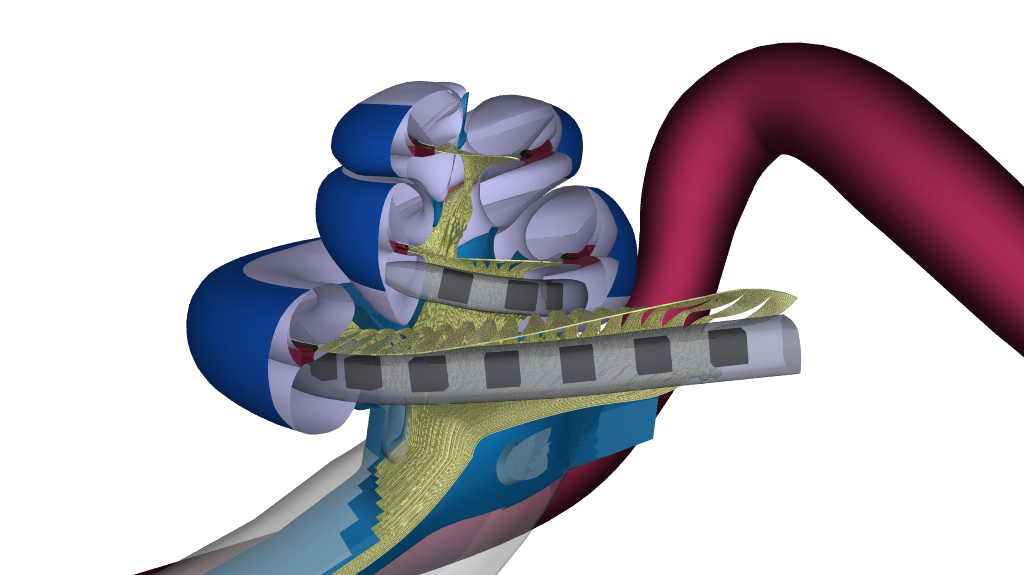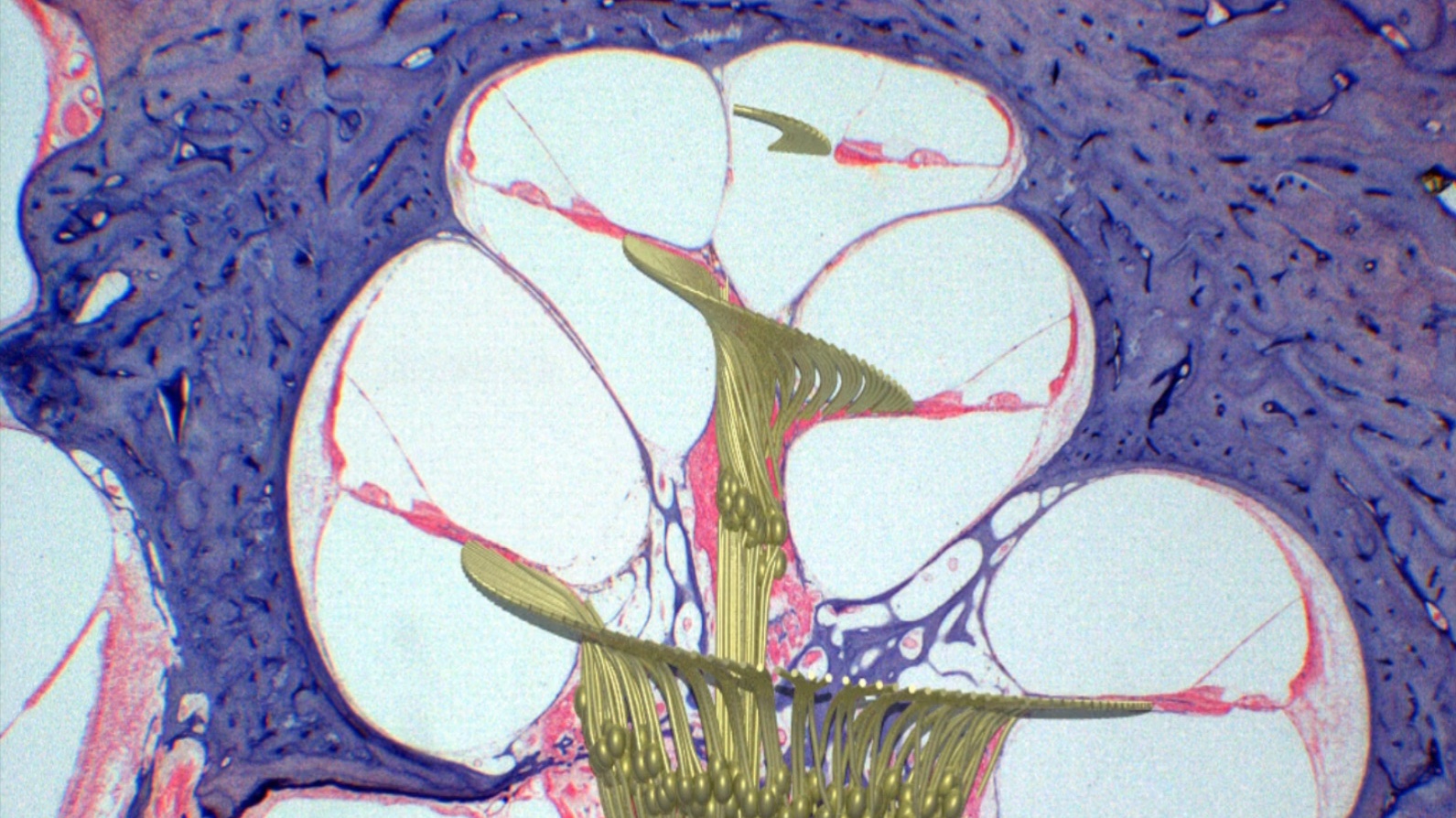Leiden cochlear implant (CI) programme
The translational research on CIs and Auditory Brainstem Implants (ABIs) is embedded and highly integrated in the second-largest Dutch clinical program on auditory prostheses for the deaf and severely hard of hearing. This clinical program is an official TRF (Top Referential Function) of the LUMC.
&width=826&height=464)
THE CI COMPUTER MODEL
The CI computer model, which is widely recognized as the most sophisticated in the world, now allows for patient-specific predictions, e.g., by integrating histological with radiological data into a frequency-to-place map. This model combines a detailed electrical volume conduction model of the human cochlea with an active (physiological) neural model. Its predictions in terms of spread of the electrical field and in terms of neural recruitment have been validated against electrical, physiological and clinical measurements in actual CI recipients. Therefore, the model has, e.g., been applied to predict the effect of various positions of existing and conceptual electrodes in the cochlea. In addition, it has been used to get otherwise inaccessible insights in the effects underlying a wide variety of speech coding strategies (e.g., on current steering and current focussing). In recent years, the model has been extended to also include a stochastic (phenomenological) neural model. Now it is also able to predict the neural response to electrical pulse trains, produced by a (digitally emulated) speech processor in response to actual speech stimuli. The model plays a key role in the Leiden research programme, as it is used in the design and evaluation of most pre-clinical and clinical studies.
…THE CI COMPUTER MODEL
The CI computer model, which is widely recognized as the most sophisticated in the world, now allows for patient-specific predictions, e.g., by integrating histological with radiological data into a frequency-to-place map. This model combines a detailed electrical volume conduction model of the human cochlea with an active (physiological) neural model. Its predictions in terms of spread of the electrical field and in terms of neural recruitment have been validated against electrical, physiological and clinical measurements in actual CI recipients. Therefore, the model has, e.g., been applied to predict the effect of various positions of existing and conceptual electrodes in the cochlea. In addition, it has been used to get otherwise inaccessible insights in the effects underlying a wide variety of speech coding strategies (e.g., on current steering and current focussing). In recent years, the model has been extended to also include a stochastic (phenomenological) neural model. Now it is also able to predict the neural response to electrical pulse trains, produced by a (digitally emulated) speech processor in response to actual speech stimuli. The model plays a key role in the Leiden research programme, as it is used in the design and evaluation of most pre-clinical and clinical studies.
IMAGING and CI
Together with the department of Neuroradiology we developed an internationally recognized CT-scan protocol for CI’s, published the world’s first paper on 7T imaging of the inner and initiated an international consensus on cochlear coordinates. Based on these achievements the relevance of in vivo imaging for cochlear implantation has been investigated, leading to assistive tools to improve implantation planning. It’s important to develop such new tools to better preserve intracochlear structures (and residual hearing) during cochlear implant-electrode insertion. E.g., as a result of a study on prospective monitoring of electrode placement, using low-dose CT-scans and direct feedback to the surgeon, we were able to induce a five-fold reduction of the number of translocations of the HiFocusMS electrode array from the scala tympani to the scala vestibuli, which is inevitably associated with complete loss of residual hearing (from over 30% to 6% of cases). A next step is the development and validation of an automatic 3D image processing app, providing pre-operative guidance to the surgeon, which will be coupled with a real-time intra-operative monitoring system, based upon electrical and electrophysiological measurements (in part via the implant itself).
CLINICAL OUTCOME RESEARCH
Clinical outcome research by our group has led to expanding candidacy indication criteria for cochlear implantation in several ways. For prelingually deafened adult CI-candidates, we were the first to show that the speech perception with CI is largely predicted by the intelligibility of the speech produced by the candidates, and we were able to develop, validate and implement a standard clinical test for candidacy for this group of marginal candidates. A study, performed in collaboration with four other Dutch and Flemish paediatric CI-centres, has largely contributed to the reimbursement of bilateral cochlear implantation in congenitally deaf children, not only in the Netherlands, but also elsewhere (e.g., the USA).
Recently, careful analysis of the pre- and postoperative speech perception outcomes in postlingually deafened adults showed that candidates have a chance of more than 90% to improve in terms of speech understanding with (unilateral) CI over (bilateral) conventional hearing aids, if their speech understanding on a standard Dutch monosyllabic word test is 80% phonemes correct or less. This has, amongst others, led to the nationwide widening of candidacy criteria for cochlear implantation.
Furthermore, we have conducted innovative clinical research, e.g., on speech coding strategies, and objective measures (amongst others, developing novel ways to determine the spread of excitation in CI with electrically evoked compound action potentials of the auditory nerve). The department has been involved in research on screening methods for hearing impairment (the DECIBEL study) and socio-emotional development of the hearing impaired. Both studies are now combined in a longitudinal evaluative study of the effects of early detection of hearing impairment and subsequent interventions on the development of children. An important finding of this research line is that deaf children with a cochlear implant show an in many respects normal socio-emotional development and significantly less psychopathology than hard of hearing children with conventional hearing aids.
Video research group
&width=826&height=464)
Projects
Themes for innovation / societal outreach
Key publications
Our team members
- Johan Frijns, Professor of Otology and Auditory Physics
- Jeroen Briaire, Clinical Physicist – Audiologist
- Christiaan Stronks, Senior researcher
- Margriet van Gendt, Clinical Physicist – Audiologist
- Randy Kalkman, PhD student
- Dick Biesheuvel, PhD student / Clinical Physicist – Audiologist
- Klaas van Groesen, PhD student / ENT resident
- Nienke Langerak, PhD student
- Bram Knipscheer, PhD student
- Savine Martens, PhD student
- Aristeidis Choustoulakis, PhD student
- Berber Mol, Research coördinator